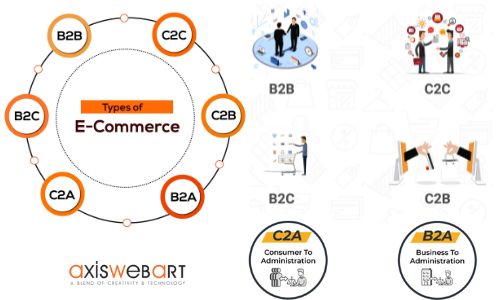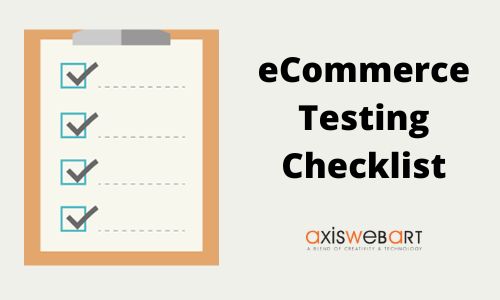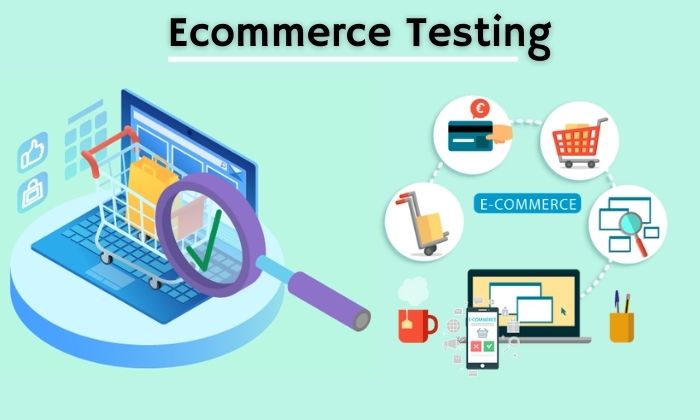eCommerce marketing strategies thrive on the very existence of online shopping and its customers. With online shopping platforms, eCommerce apps are replacing the traditional in-store shopping experience.
User experience becomes a priority to ensure the success of an eCommerce website or mobile app. But to establish an exceptional user experience, it is the job of the eCommerce business to make certain that there are no defects within their website or applications. eCommerce testing is an essential point when we talk about sales, user engagement time, reviews, and feedback.
And if any such situation arises, they should be capable of resolving multiple issues at once to have a profitable business. Therefore, to guarantee the success of an eCommerce platform, one should know how to test an eCommerce website.
Why Must It Be Done?
eCommerce testing is a process through which the functionality of an eCommerce website or application can be assessed.
Through this process, the eCommerce performance testing and security testing for eCommerce websites that are most prone to several risks and issues (such as international cyber threats and financial risks) can be resolved.
This can be checked when one knows the test cases and how to write test cases for eCommerce websites.
Moreover, eCommerce website development always helps to keep certain factors in check and these include mobile responsiveness, customer data security, etc. Since the eCommerce test plan ensures defect-free (or user-friendly) applications and websites, a powerful risk management process is developed which helps in providing exceptional customer experience thus ensuring a profitable business.
How Is eCommerce Testing A Quality Risk Savior?
Besides the unsatisfied clientele, a demo eCommerce website for testing can help one prevent many other potential complications like-
- Unavailability of an online store
eCommerce software testing can help in preventing this risk that originates from the provider’s end, especially during eCommerce load testing, such as during holiday sales.
- Poor analytics
Further, eCommerce project descriptions for testing can help prevent misleading analytics. Since website analytics allows one to attain insights about website traffic, poor analytics testing refrains an eCommerce business from obtaining reliable information to assess overall marketing strategies, thus leading to a great loss in the business.
Types Of eCommerce Websites And Applications

Before we talk about the sequence for eCommerce testing, it is important to acknowledge and understand the different types of eCommerce website designs and apps.
This is crucial, as even though an automation check is time-efficient that gives time to market, not every eCommerce website would require robust test cases which are primary for bigger eCommerce website testing.
This means, that a testing sequence will be larger for an eCommerce website such as Amazon but will be smaller for a local eCommerce business.
Due to the reason stated above, the categorization of eCommerce websites and applications is important, and this categorization is governed by the buyer, and seller within five categories:
- The Business-to-Business model (B2B)
Here, one business helps another business via an online platform. Examples of the B2-B model are Amazon, Alibaba, IndiaMart, General Electric, Walmart, etc.
- The Business-to-Consumer model (B2C)
Within this model, the customer directly buys a product from a business via an online store. An example of this business model could be Uber.
- The Consumer-to-Business model (C2B)
Just as a freelancer must produce good content to sell their product to big companies, this model requires the customer to directly sell their goods or provide their service to large business organizations.
- The Customer-to-Customer model (C2C)
Within this model, an individual sells their products directly to the customer. Some examples of this type of eCommerce business model are eBay, Alibaba, and OLX.
- The Customer-to-Administration model (C2A)
This model requires a business transaction to occur between an individual and the public administration. In other words, the process of booking a flight ticket is an example of the C2A model.
Crucial eCommerce Testing Test Cases – Ecommerce Testing Challenges
Prior to discussing some of the most important testing cases, it is important to understand the meaning of the term “test cases” itself. Test cases are mostly either scripted or non-scripted scenarios, that are formulated to check the functionality of an eCommerce website.
Checklist for eCommerce Website Testing

-
General test cases
As the word general itself suggests, the general test case is an overlay test that is concerned with the functionality of all the main pages within an eCommerce website or application.
In other words, this means, it tests that from the minutest details, such as the visibility of the product picture to the navigation features, all these general features are functioning properly or not.
Amongst many different tests, some of the general tests that are required to be performed are:
- Whether the product image, price, name, description, and the company logo are visible or not,
- If all the categories have relevant products listed under them,
- Whether the website links are redirecting the customers to the correct product or page or not, and
- Whether the product list view displays the correct quantity of the products selected or not.
-
Homepage testing cases
Just like a profile picture becomes the forefront of one’s social media presence, similarly, the homepage of a website dictates whether while shopping for a product, its superficial characteristics (i.e. how a web development company designs the website) alongside easy navigation capture a customer’s interest or not.
So, because the homepage is more than just a space listing different categories or pages available on the eCommerce website, it is important for quality assurance (QA) and quality engineering (QE) services to test for some crucial things on it, such as:
- If the loading speed is too quick or too slow,
- If scrolling on the homepage leads to the next one or id hovering does the same,
- Whether the colors or themes of all the pages are similar to the homepage, and
- If all the categories listed on the homepage are redirecting the customer to the right destinations.
-
Search test case
Before the homepage, there are times when customers tend to look for a specific product using the search tools from the eCommerce testing tools impulsively.
So, with an easy-to-approach and understandable search design, the user experience can be enhanced to make it easier for the customers to look for the exact product they want without getting lost within the application by hiring dedicated developers.
Some of the test scenarios for testing an ecommerce website could be:
- Whether or not different filter or sort options are made available to the customer,
- Whether these sort or filter options do the job they are designed to do,
- If the search available is based on the brand name or the product’s name or any other specificities,
- If there are several products available on the website and are multiple pages and options easily accessible to the customer, and
- Whether the navigation amongst several pages is easy.
-
Product details page test case
After deciding on the product, the customer tends to compare several products side-by-side to make the best selection based on the product information available on the page.
Therefore, it is in the best interest of the web/ mobile app development company to provide as much information about the product as they can on their website, to make it easier for the customer to purchase the product without any second thoughts.
So, the sample test cases for an eCommerce website testing would include:
- Whether the price, picture, size and other specifications of the product are mentioned or not,
- Whether the reviews made by other customers for the same products are visible or not,
- If the check-out options and in-stock/out-of-stock details are mentioned or not,
- The delivery options available and if the delivery options differ when the customer is making a guest purchase and when they are a member of the Commerce website.
- Is the shipping information made available for editing later as well or not?
-
Recommended products test case
Now, in a good eCommerce business, the website development company and engineer tend to understand that the art of displaying recommended products is at times much more essential to get more money into their bag.
Because displaying relevant recommendations ensures the purchase of more products and the loyalty of the customers, it is important to test:
- Whether the recommendations being made are relevant to the current product being purchased or not,
- If the recommendations being made are optimized to every individual client’s search history or history of purchases or just the current one, and
- Whether or not recommendations are being displayed after the product is purchased or right under it before the payment is done.
-
Payment test case
A business can lose a large clientele if the latter sense a security threat towards their money or payment method. Most customers tend to exit a website when either universal payment methods are made unavailable, or when they experience unsuccessful or failed transactions a couple of times. Since the payment step ensures the trust of the customers.
eCommerce mobile app testing must test:
- Whether different payment options are available and working or not,
- If customers need to be registered as a member on the eCommerce website to purchase goods or are guest payments and purchases available as well,
- Whether or not the financial information of a customer, such as credit card details, is automatically being saved, or is the customer given a choice to not save this information for future purchases,
- Whether after payment the customer receives an order confirmation, and if they do, is it in the form of a text or email with the product details and order reference number or not, and
- Once payment has been completed, which page is the customer directed to.
- Shopping cart test case
While surfing for a specific product, a customer is likely to come across other products that they do not require instantly, but they still want to add them to their wish list for future purchases. Or in other cases, the customer might want to store multiple items to buy them all at once, after they are done browsing.
For this eCommerce website testing test cases must test:
- Whether the shopping cart provides the options for deletion and saving for later to the customer or not,
- Whether the total amount of all the items within the cart is displayed or not,
- If in the totaling costs, taxes based as per locations are displayed, and
- Whether or not any available offers, coupons, or deals are displayed to the customer, and if they are then it has to be checked if the total amount after applying the coupons is made visible to the customer or not.
- Post-order test cases
Several things can be made available to the user to display that your business is concerned about the customers even after purchase. Therefore, testing the post-purchase functionality is an important step as well. Here, you should check:
- Whether the customer can rate the product after receiving it,
- Whether or not their purchase order history is up to date,
- If the customer can change the billing or shipping address and payment options or not, and
- Whether or not the customer can apply for a replacement of the product or a refund for returning the product.
Apart from this, several other features must be investigated by website development services. This includes social buttons, website accessibility, navigation systems, cookies, etc. Moreover, these eCommerce websites and applications must be functional on all types of web browsers.
After browser compatibility is matched, eCommerce SEO-related marketing strategies (such as title tags, URL structures, image alt tags, search engine tags, etc.) need to be implemented accurately to ensure the growth of the business.
Furthermore, even mobile application development companies must carry out these tests for a smooth user experience even on their smartphones, therefore, hiring android developers or iOS developers is a necessity.
Conclusion of Ecommerce Testing
To conclude, efficient yet effective testing often indicates a seamless and profitable business that provides exceptional customer service and experience.
The issues that have been addressed in the article must be considered to ensure the smooth sailing of the business. The business must accumulate a loyal customer base and ensure that the customer base remains consistent throughout the life of the website or application.
A business can earn a disreputable image, owing to dissatisfied customers, which leads to loss of marketing, missing sales opportunities, and eventually, downfall within the eCommerce business.
Therefore, businesses need to maintain constant communication with their QA and QE teams to ensure the testing of their eCommerce website testing tools and mobile app to remove any conflicts that might snowball into unexpected bad business.
So, a test plan for an eCommerce website as outlined through the eCommerce testing checklist is mandatory for obtaining good results in a business.



